Beyond the familiar orange, our planet offers a huge plethora of orange fruits, each boasting its unique flavor and story. Have you ever found yourself curious about these vibrant gems at a market or during travels to other sides of the world? From the widely loved to the exotic, this article will guide you through 17+ orange fruits, enriching your fruit knowledge and palate. Let’s get into it!
1. Orange (Citrus × sinensis)
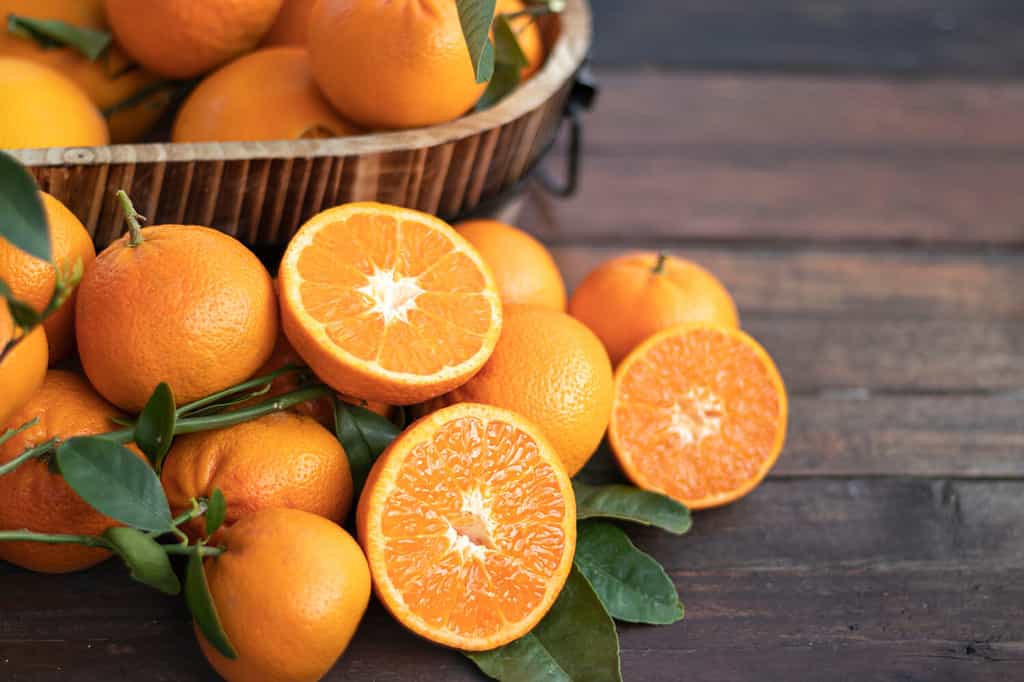
One of the first fruits to come to mind when you think of orange fruits is the orange!
©PradaBrown/Shutterstock.com
Of course, the most famous orange fruit is none other than the orange itself! The orange is often associated with a refreshing burst of citrusy delight. At first glance, its round and slightly textured skin, ranging from a sun-kissed orange to deep, rich amber, promises a juicy interior. The skin, when pressed, exudes a fragrant aroma that is often used as perfume as well. When you peel back the fruit’s skin, you’ll see segments packed closely together, each bursting with that familiar tangy sweetness. The taste of an orange is a blend of sweetness and tartness with a zesty undertone.
2. Kinnow (Citrus nobilis x Citrus deliciosa)
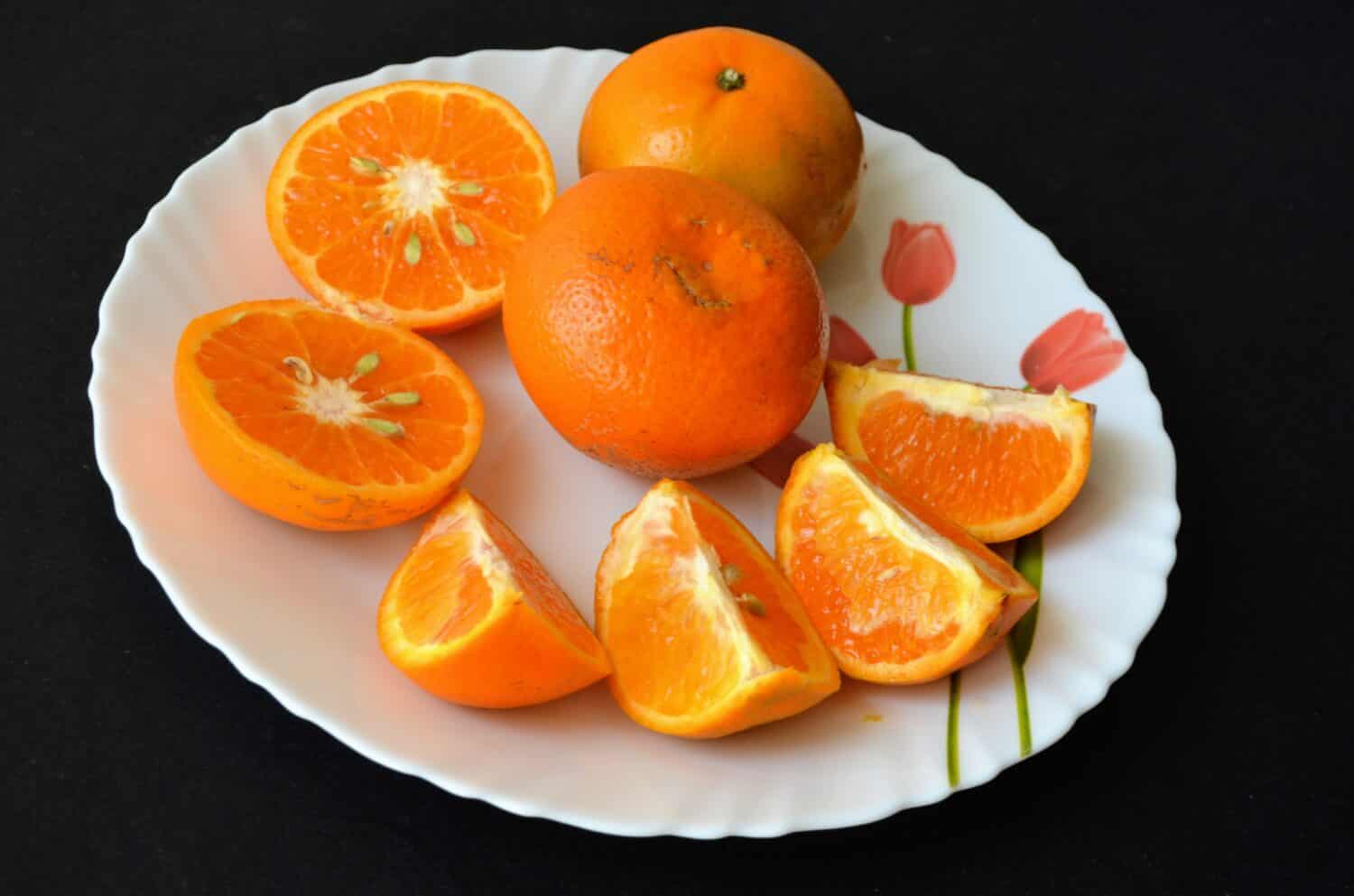
A mandarin hybrid, the kinnow boasts a deep golden-orange hue.
©Bhupinder Bagga/Shutterstock.com
Another delicious fruit that is orange in color is the kinnow, a type of mandarin hybrid. Externally, it has smooth, shiny skin with a deep golden-orange hue. In terms of size, it is slightly smaller than the typical orange, but it still delivers the same level of punch of flavor. Like the orange, the skin’s aroma hints at its contents. It is also relatively easy to peel than other citrus varieties. Inside, the kinnow has several segments. And when you finally bite into a kinnow, you’ll find a sweet and tangy fruit with a slightly tart edge accentuating its flavor.
3. Tangerine (Citrus reticulata)
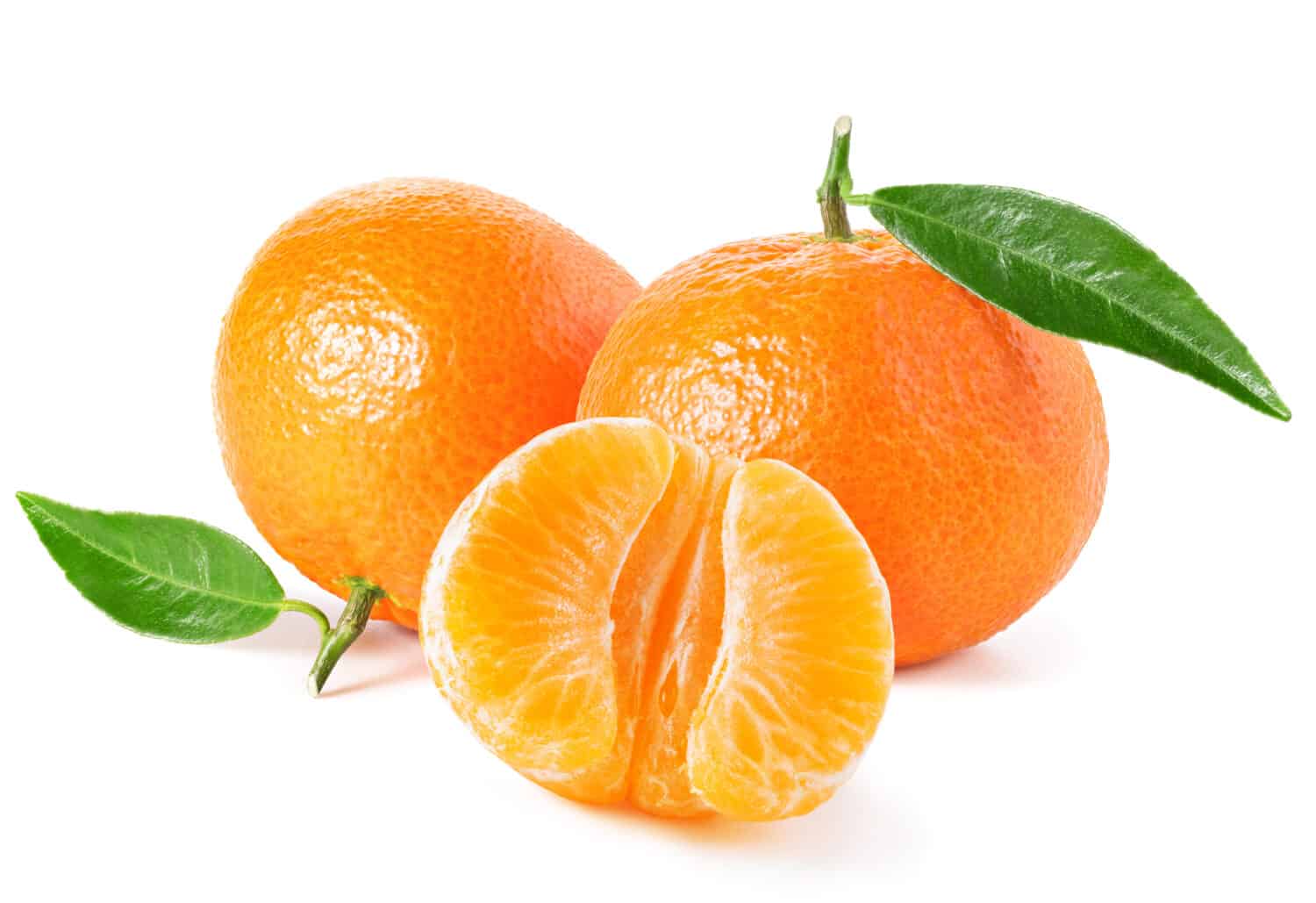
Another famous orange fruit is the tangerine.
©Svetlana Serebryakova/Shutterstock.com
The tangerine is another orange fruit that captivates with its bright orange skin with a slight reddish tinge. Smaller and more compact than many of its other citrus counterparts, it has a thin, easy-to-peel rind that emits a fragrant aroma when slightly squeezed or zested. Beneath this protective layer, the fruit has segments and lacks the bitterness of some white membranes found in other orange-type fruits. The taste of the tangerine is very sweet with a subtle tang. This fruit’s juicy, tender flesh almost melts in the mouth, making it a delicious snack to easily eat on the go.
4. Grapefruit (Citrus × paradisi)
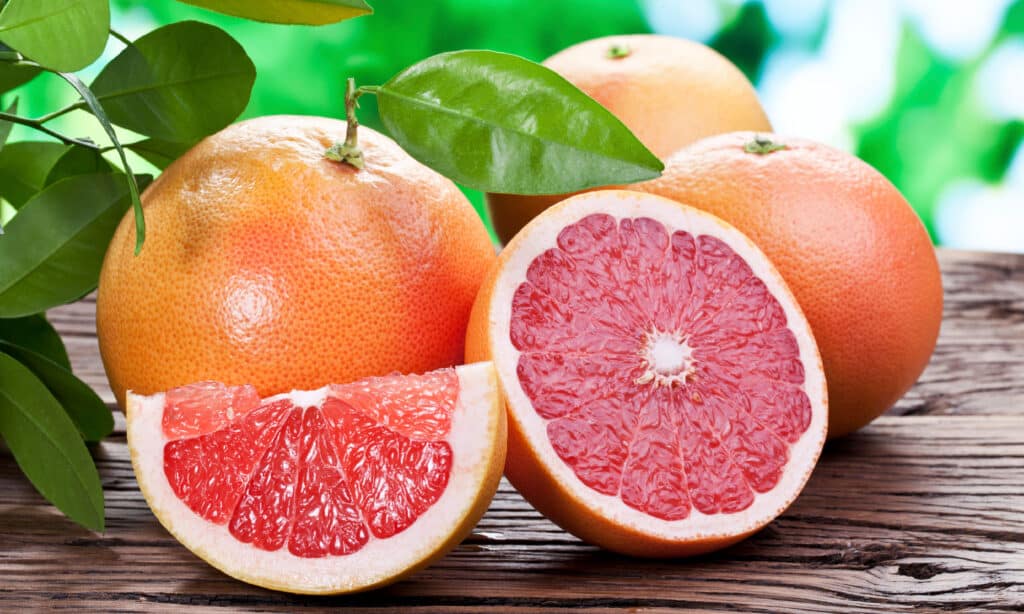
Grapefruit has a smooth, glossy orange skin.
©iStock.com/ValentynVolkov
Outwardly, the grapefruit’s spherical form boasts a smooth, slightly glossy skin that can vary from a pale orange to a rosy pink or rich red, depending on the variety. Its name might be misleading, as it doesn’t resemble a grape at all. Instead, the name stems from how the fruit grows in clusters on trees, just like grape bunches. Upon slicing this fruit open, you will see a segmented interior that mirrors the color of the skin, with some varieties showcasing a deeper red color.
The grapefruit is a complex mix of flavors: it has a dominant tartness with varying degrees of bitterness underlined by a subtle sweetness. This interesting flavor makes it a refreshing standalone snack and a versatile ingredient in salads and beverages. Many people like to eat grapefruit with some sugar on top to cut out the bitterness.
5. Kumquat (Citrus japonica)
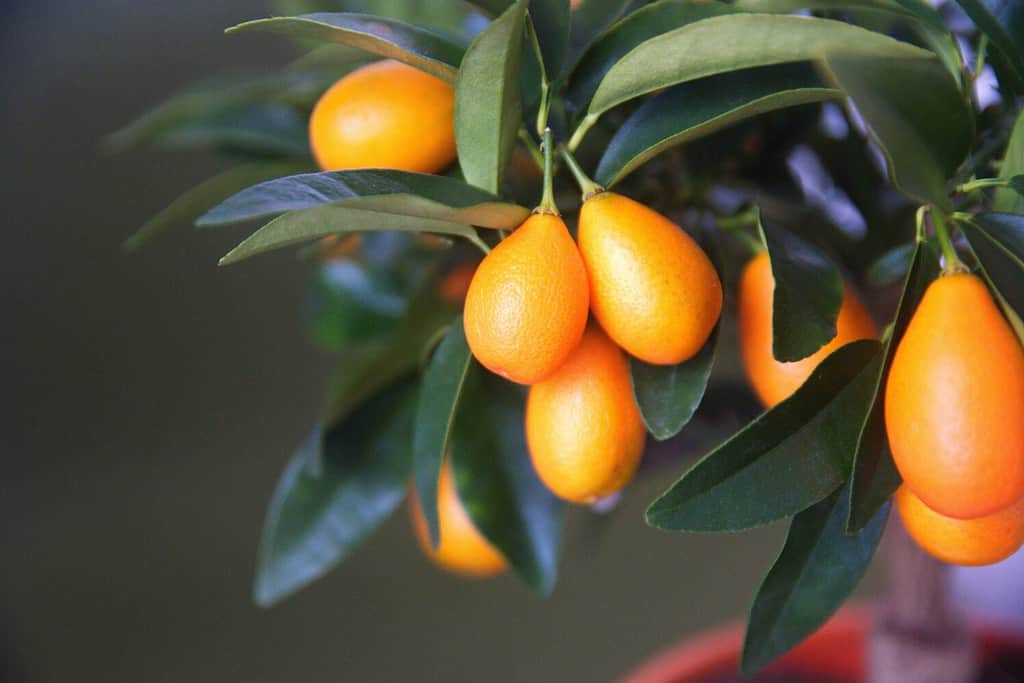
With a very tart taste, the kumquat is perfect for garnishing and making preserves!
©aniana/Shutterstock.com
The kumquat stands out not just for its size but also for its unique taste. Resembling a miniature oval or oblong orange, its skin is bright, glossy golden, and smooth to the touch. What sets the kumquat apart from other citrus fruits is its edible rind, which is surprisingly sweet and tender, contrasting brilliantly with the tartness of its inner flesh. When bitten into, the initial burst of sweetness from the skin is followed by a zesty, tangy kick from the pulp. This makes kumquats a favorite for snacking, garnishing, and making preserves.
6. Blood Orange (Citrus × sinensis ‘Blood orange’)
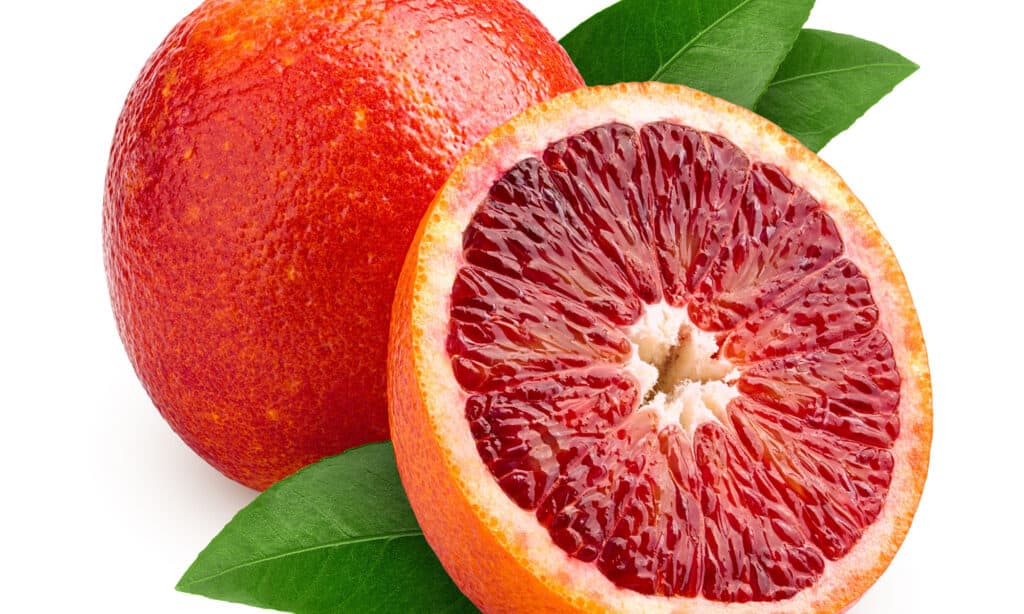
As its name suggests, the blood orange has a blood-red interior.
©grey_and/Shutterstock.com
The blood orange is instantly recognizable by its striking, sometimes mottled, deep orange or ruby-red hue. Its external appearance can be a mix of orange and crimson. Slicing into this fruit unveils its namesake feature: a vibrant flesh that ranges from a speckled pink-orange to a profound, almost burgundy red. This color results from anthocyanins, a type of antioxidant, which are rare in citrus fruits and give these fruits their unique coloration.
The taste of a blood orange is equally fascinating and delicious. It has a sweet citrus base with subtle undertones of berries, notably raspberry. Its flavor profile is richer and more complex than your traditional orange. Its slight tartness complements its sweetness, making it a favored choice for refreshing beverages when freshly squeezed.
7. Mandarin (Citrus reticulata)
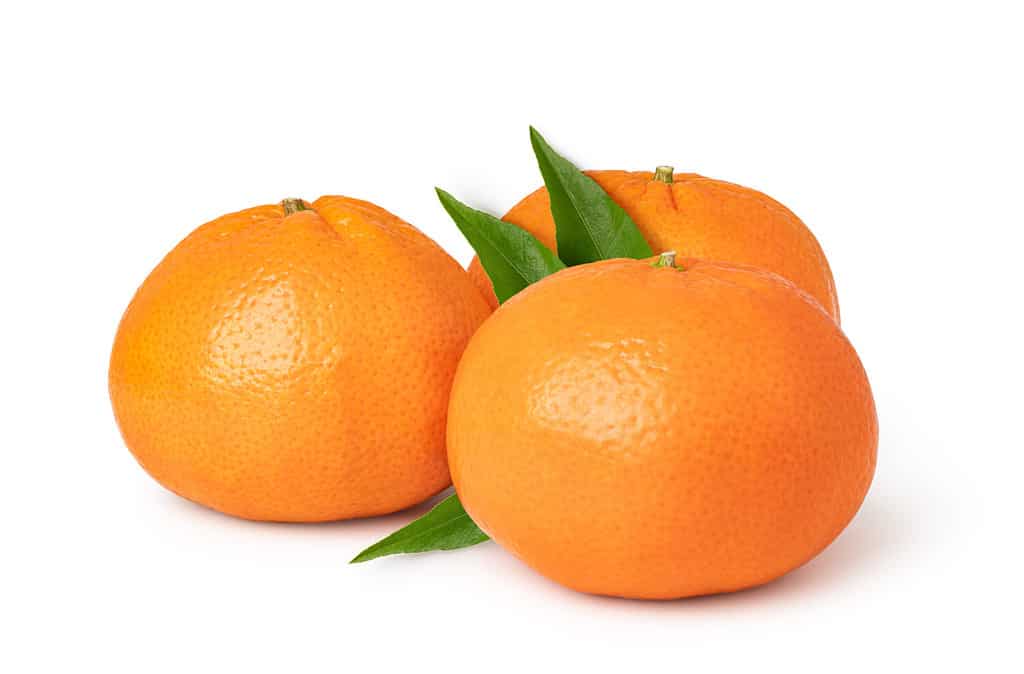
Mandarins are petite and have a softer and looser skin than other citrus fruits.
©gresei/Shutterstock.com
One of the first fruits that’ll pop into mind when thinking of orange fruits is mandarin. The mandarin, often hailed as one of the ancestors of many modern citrus varieties, is petite and has a slightly flattened form. Its skin is a vibrant shade of orange, often softer and looser than other citrus fruits, making it especially easy to peel. Beneath this protective layer, the mandarin has juicy segments, each with a translucent sheen and separated by thin membranes.
The mandarin offers a lovely taste, its sweetness only faintly tinged with tartness. Unsurprisingly, this fruit is a favorite among children and adults alike.
8. Seville Orange (Citrus × aurantium)
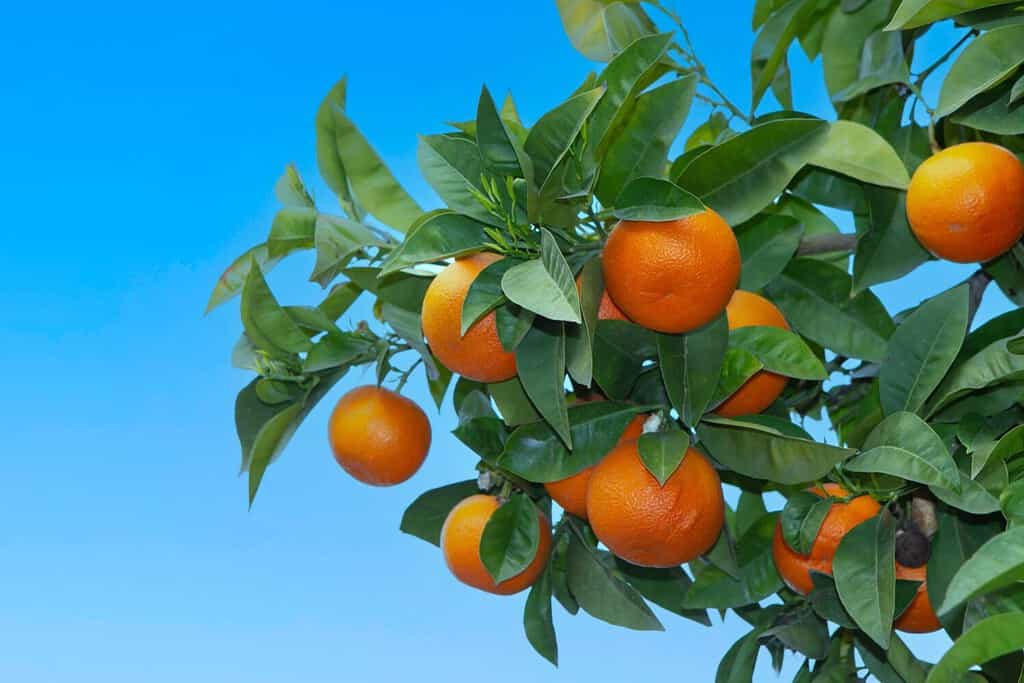
Bitter orange, or Seville orange, has a rougher, textured skin than your traditional orange.
©Thanasis F/Shutterstock.com
The Seville orange, often called the “bitter orange,” visually mimics the familiar round shape of other oranges. However, its skin is rougher, with a textured, pebbled surface ranging from a bright yellow-orange to a deeper, muted color. This fruit’s standout feature is its unique taste profile. Unlike the sweet oranges that dominate most grocery shelves, the Seville orange is, as its moniker suggests, notably bitter. The flesh, though juicy, haws a sharp tanginess accompanied by a pronounced bitterness, making it less desirable as a standalone snack. However, this characteristic has cemented its place in marmalades, in particular, where its flavor shines. Additionally, the Seville orange’s zest adds depth to dishes, and its juice, often along with other ingredients, plays a crucial role in many savory and sweet recipes.
9. Apricot (Prunus armeniaca)
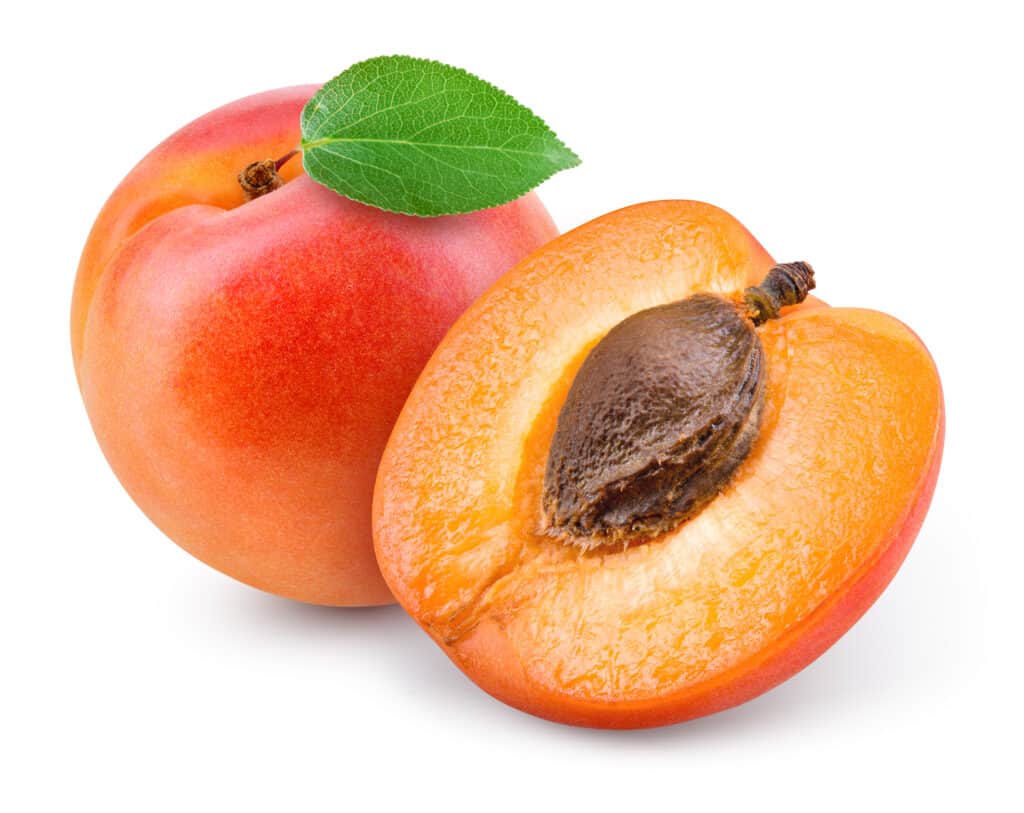
Many people enjoy the dried version of the apricot fruit.
©Tim UR/Shutterstock.com
At first glance, the apricot has an exterior that ranges from a soft, pale yellow to a deep, sun-kissed orange. Often, it may even bear a rosy blush on the side. Its skin, velvety to the touch, guards the flesh within. Once bitten into, the apricot reveals its unique taste: a harmonious blend of sweet and tart. Its taste has hints of floral undertones and honeyed sweetness. This fruit’s appearance and flavor are a favorite of many. In particular, many individuals enjoy eating apricots in their dried form.
10. Calamansi (Citrus × microcarpa)

Although calamansi fruits turn orange when ripe, they are mostly used in their unripe state (pictured).
©Nokuro/Shutterstock.com
The calamansi, also known as calamondin or Philippine lime, is a petite citrus commonly found in Southeast Asian regions. On the branch, it is a cluster of small, round fruits, each about the size of a large marble. This fruit has smooth, glossy skin that transitions from a deep green when immature to a bright, sunny yellow or a pale orange when fully ripe. Despite its smaller size, the calamansi packs an impressive punch in the flavor department. This fruit is incredibly sour but is accompanied by subtle sweetness. Due to its fragrant citrus aroma, this distinct tartness makes the calamansi a favored choice for adding zesty flair to beverages, marinades, and various dishes.
11. Pumpkin (Cucurbita)
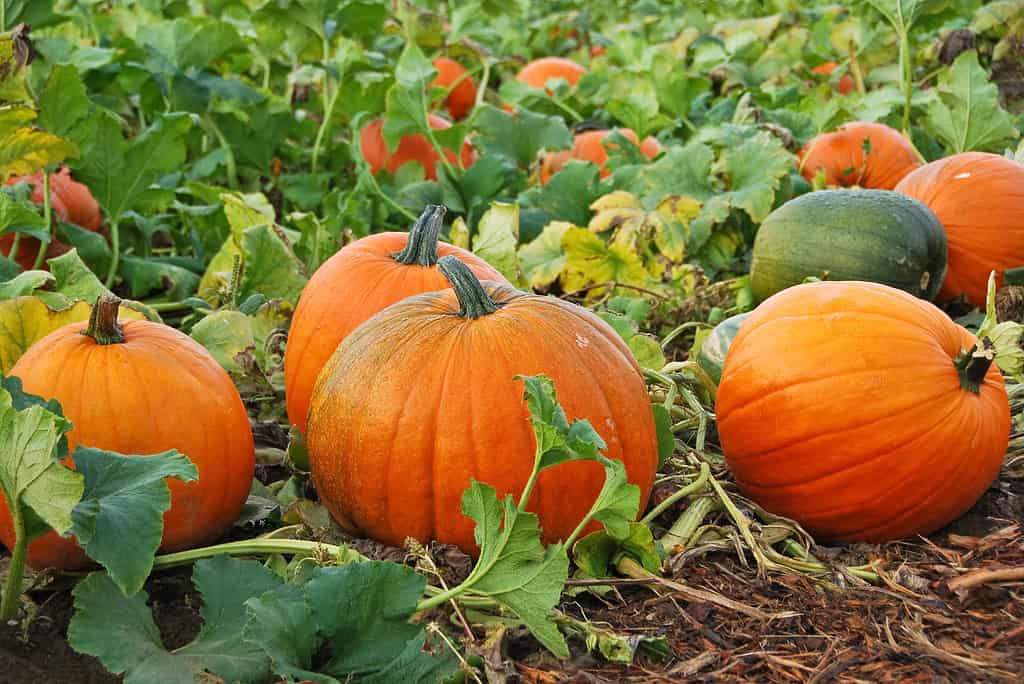
A huge orange fruit, the pumpkin has a mildly sweet and rich flavor.
©Loren L. Masseth/Shutterstock.com
The pumpkin is a celebrated fruit for its aesthetic, culinary, and holiday charm. Visually, it stands out with its robust, rounded form and deeply ribbed surface. Its thick, protective skin comes in shades from rich, deep oranges to greens and whites. Often gnarled and woody, the stem starkly contrasts the fruit’s smooth or slightly rough texture. Inside, the pumpkin houses a hollow cavity teeming with seeds and fibrous strands. Its flesh is dense and vibrant, with an orange hue more intense than its outer shell. When it comes to taste, pumpkins are mildly sweet and rich. When cooked, their texture becomes soft and creamy, intensifying their flavor, making them a beloved ingredient in pies, soups, roasts, and many other savory and sweet dishes.
12. Butternut Squash (Cucurbita moschata ‘Butternut’)
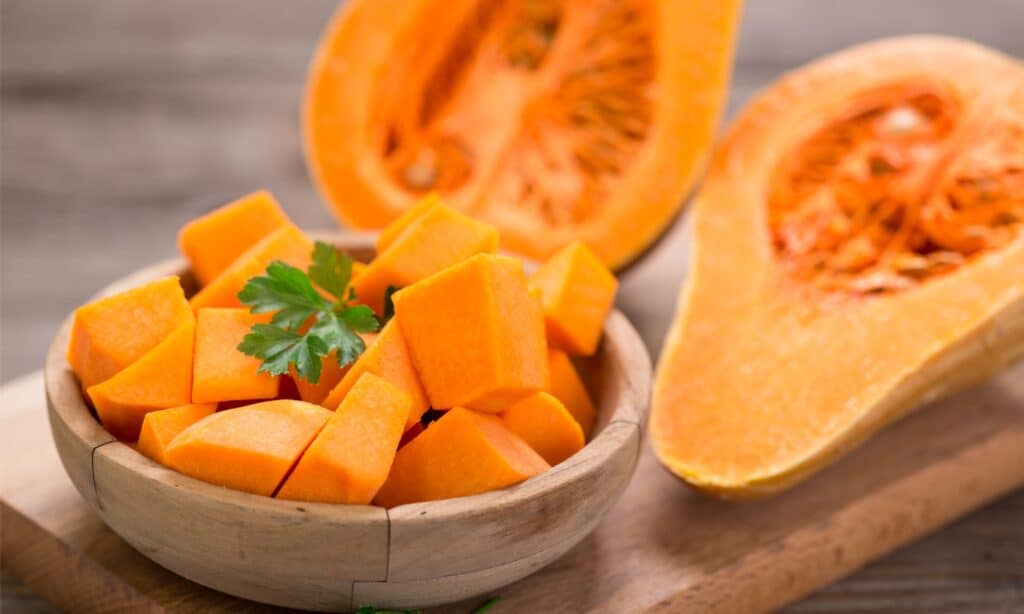
One of the best ways to enjoy butternut squash is to use it in risottos and soups.
©iStock.com/pilipphoto
The butternut squash’s elongated, bell-like shape begins with a slender neck that expands into a bulbous base. The smooth, orange-tan colored skin protects the brightly orange flesh within. A central cavity on the broader end houses a small collection of seeds. Regarding its flavor profile, butternut squash boasts a rich, nutty taste that melds a natural sweetness with earthy undertones. The flesh turns soft upon cooking, and its sweetness is further accentuated, making it a versatile star in savory dishes, like risottos and soups, and sweet preparations as well, such as pies and muffins.
13. Persimmon (Diospyros kaki)
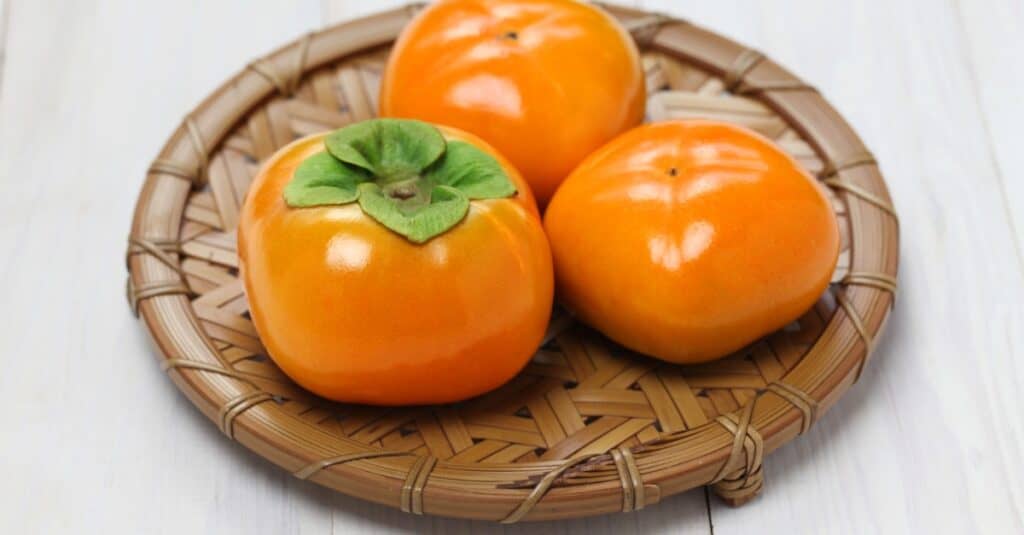
A rich orange in color, the persimmon almost looks like a tomato.
©iStock.com/bonchan
The persimmon, a fruit often associated with the fall season, stands out with its vibrant hues that can mirror the colors of fall leaves. This fruit is shaped somewhat like a tomato and has smooth skin transitioning from a glossy green when young to a deep, rich orange or sometimes red hue when fully ripe. Inside, the fruit’s flesh can vary depending on the variety. In fact, the two most popular types offer contrasting taste experiences. For example, the fuyu has a crisp, sweet flavor with a hint of honey and can be eaten while still firm. In contrast, to avoid its natural astringency, the hachiya persimmon must be eaten when it’s soft, almost gelatinous. Once ripe, it offers a lush, sweet taste with brown sugar and apricot nuances.
14. Red Kuri Squash (Cucurbita maxima)
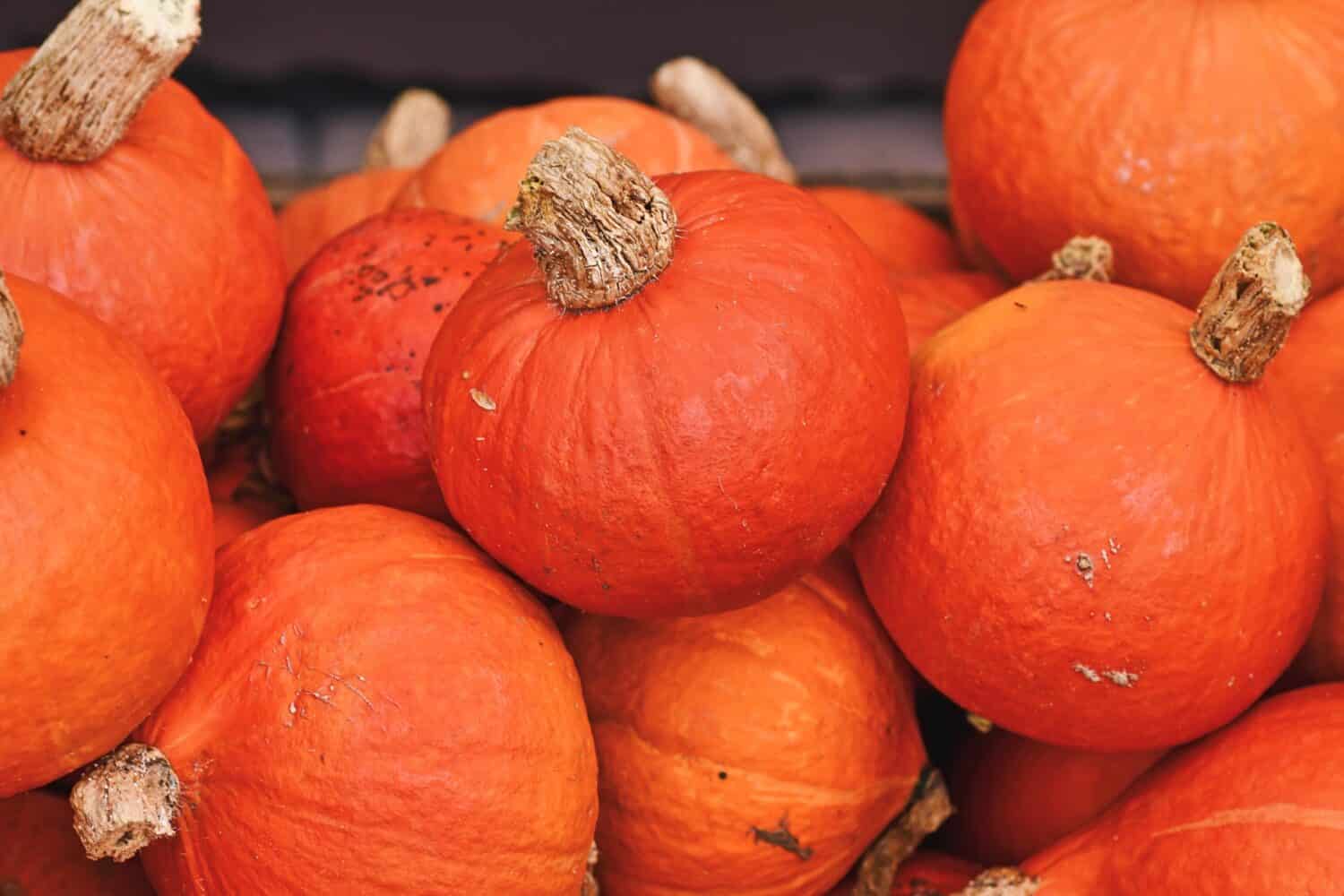
With a deep orange hue, the red kuri squash resembles a teardrop in shape.
©Firn/Shutterstock.com
Red kuri squash is another orange fruit that has a vibrant, deep-orange hue and distinct shape. Resembling a teardrop or a slightly oversized acorn, the red kuri has smooth, hard skin, often with slight ribbing. Once cut open, the red kuri squash reveals a dense, golden-orange flesh surrounding a seed-filled central cavity. Flavor-wise, the red kuri squash stands out with its sweet yet nutty profile, almost like chestnuts, with a hint of buttery richness. When cooked, the texture of the red kuri squash becomes smooth. This squash’s mellow, earthy sweetness and creamy consistency make it ideal for various dishes such as soups and purees to roasted side dishes.
15. Mango (Mangifera indica)
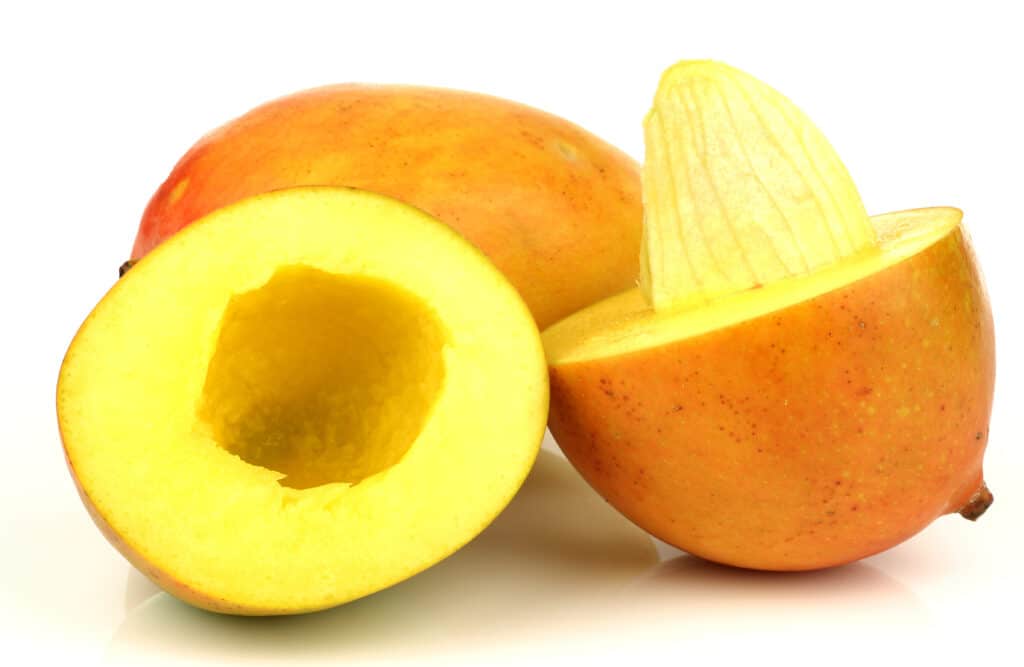
Mangos can come in many colors, including gold, amber, orange, green, and deep red.
©Peter Zijlstra/Shutterstock.com
Originating from tropical areas, mangos display a variety of shapes, stretching from elongated to almost round. Their exterior is a medley of colors, from golds and ambers to deep reds, occasionally interspersed with shades of green, depending on the particular type of mango. Hidden beneath this colorful exterior is a lush, amber-colored flesh encircling a large, stringy core. When fully ripe, the mango is rich and sweet, enhanced by flavors evoking fruits such as peaches, pineapples, and assorted citrus. The mango’s pulp is smooth and creamy in texture.
16. Orange Cherry Tomato (Solanum lycopersicum)

Comparable in size to a large blueberry, the orange cherry tomato is refreshingly sweet.
©Ewa-Saks/Shutterstock.com
The orange cherry tomato is a variation of the traditional cherry tomato, known for its beautiful hues and delicious taste. This fruit is comparable in size to a large blueberry and has glossy, bold orange skin. In terms of taste, the orange cherry tomato is refreshingly sweet with a slight tanginess, reflecting its tomato heritage. This combination of flavors makes it a favorite ingredient in a range of dishes, from simple salads to more sophisticated meals.
17. Marian Plum (Bouea macrophylla)

The Marian plum tastes like a combination of persimmon, apricot, and mango.
©apiguide/Shutterstock.com
Although the Marian plum may look like an apricot, but it is more closely related to the mango. An edible tropical tree fruit, the Marian plum has smooth, yellow-orange skin when ripe, but when unripe, it is green in color. Although the skin is much thicker than your typical plum, the skin is meant to be eaten and can provide a satisfying crunch that contrasts with the juicy orange flesh within. In terms of taste, this fruit tastes like a combination of persimmon, apricot, and mango, with a sweet and sour taste.
Comprehensive List of All Orange Fruits
- Orange
- Kinnow
- Tangerine
- Grapefruit
- Kumquat
- Blood Orange
- Mandarin
- Seville Orange
- Apricot
- Calamansi
- Pumpkin
- Butternut Squash
- Persimmon
- Red Kuri Squash
- Mango
- Orange Cherry Tomato
- Marian Plum
- Orange Bell Pepper
- Golden Berry
- Peach
- Clementine
- Cantaloupe
- Cape Gooseberry
- Papaya
- Nectarine
- Tangelo
Summary of Orange Fruits
| Number | Fruit | Scientific Name |
|---|---|---|
| 1 | Orange | Citrus × sinensis |
| 2 | Kinnow | Citrus nobilis x Citrus deliciosa |
| 3 | Tangerine | Citrus reticulata |
| 4 | Grapefruit | Citrus × paradisi |
| 5 | Kumquat | Citrus japonica |
| 6 | Blood Orange | Citrus × sinensis ‘Blood orange’ |
| 7 | Mandarin | Citrus reticulata |
| 8 | Seville Orange | Citrus × aurantium |
| 9 | Apricot | Prunus armeniaca |
| 10 | Calamansi | Citrus × microcarpa |
| 11 | Pumpkin | Cucurbita |
| 12 | Butternut Squash | Cucurbita moschata ‘Butternut’ |
| 13 | Persimmon | Diospyros kaki |
| 14 | Red Kuri Squash | Cucurbita maxima |
| 15 | Mango | Mangifera indica |
| 16 | Orange Cherry Tomato | Solanum lycopersicum |
| 17 | Marian Plum | Bouea macrophylla |
| 18 | Orange Bell Pepper | Capsicum annuum |
| 19 | Golden Berry | Physalis peruviana |
| 20 | Peach | Prunus persica |
| 21 | Clementine | Citrus × clementina |
| 22 | Cantaloupe | Cucumis melo var. cantalupensis |
| 23 | Cape Gooseberry | Physalis peruviana |
| 24 | Papaya | Carica papaya |
| 25 | Nectarine | Prunus persica var. nucipersica |
| 26 | Tangelo | Citrus × tangelo |
The photo featured at the top of this post is © Bhupinder Bagga/Shutterstock.com
Thank you for reading! Have some feedback for us? Contact the AZ Animals editorial team.







